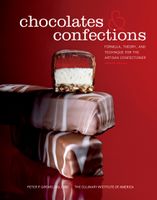Label
All
0
Clear all filters
🔥 Try our grilling cookbooks and save 25% on ckbk membership with code BBQ25 🔥
Applying Dry Luster Color
Appears in
By Peter Greweling and Culinary Institute of America
Published 2007
Dry colors approved for use in food may be dusted lightly into a mold before filling the mold with chocolate, or they may be mixed with cocoa butter and brushed in. When applied dry, these colors create an entirely different effect from the one created by liquid colors.

Shell-Molded Chocolate Defects
| Defect | Cause | Remedy |
| Poor Shine | Mold not well polished | Polish mold well after washing |
| Mold in poor condition | Use mold with smooth, clean interior | |
| Chocolate over- or undertempered | Use optimally tempered chocolate | |
| Chocolate applied while too cool | Apply chocolate at maximum working temperature | |
| Brushed-in chocolate overcrystallized | Stop brushing chocolate before it crystallizes | |
| Difficulty Releasing | Chocolate over- or undertempered | Use optimally tempered chocolate |
| Chocolate not fully set | Allow chocolate to set longer | |
| Chocolate not cooled enough | Chill chocolate more to allow it to contract | |
| Shell too thin | Leave chocolate in longer before inverting mold to drain away excess | |
| Bubbles on Surface | Chocolate overtempered | Use optimally tempered chocolate |
| Molds too cold | Warm molds to 25° to 30°C/77° to 86°F before filling | |
| Chocolate too viscous | Use chocolate with higher cocoa butter content | |
| Mold not vibrated sufficiently | Vibrate mold well to remove air bubbles | |
| Dull Spots on Surface | Mold not warmed before use | Warm mold to 25° to 30°C/77° to 86°F before filling |
| Mold not polished well | Polish mold well after washing | |
| Bloomed Chocolate | Undertempered chocolate used | Use optimally tempered chocolate |
| Do not refrigerate too long | ||
| Excessive humidity | Work in low-humidity environment | |
| Latent heat of crystallization not released | Chill molds as they crystallize | |
| Oozing Center | Overfilled mold | Fill mold only to within 2 to 3 mm/1/16 to ⅛ in of the top |
| Shell too thin | Allow filled molds to sit longer before removing excess chocolate | |
| Inadequate adhesion of cap | Warm the mold slightly before capping | |
| Flaking Surface | Brushed-in chocolate overcrystallized | Stop brushing chocolate before it crystallizes |
| Mold not well polished | Polish mold well after washing | |
| Cracked Shell | Refrigerated too long | Remove from refrigerator sooner |
| Shell too thin | Leave chocolate in longer before inverting mold to drain away excess |
Become a Premium Member to access this page
Unlimited, ad-free access to hundreds of the world’s best cookbooks
Over 160,000 recipes with thousands more added every month
Recommended by leading chefs and food writers
Powerful search filters to match your tastes
Create collections and add reviews or private notes to any recipe
Swipe to browse each cookbook from cover-to-cover
Manage your subscription via the My Membership page
Best value
Part of
Advertisement
Related Recipes
-
-
-
-
Related Reference
-
-
-
-
Advertisement
The licensor does not allow printing of this title




